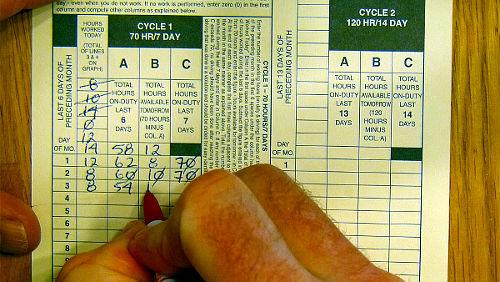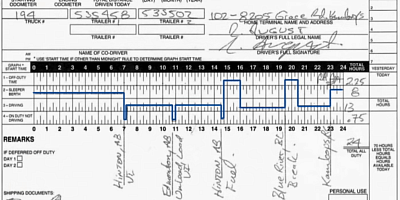Many drivers get a violation for exceeding their work cycle hours.
Log Books | Calculating Work Cycle
Updated Jan 2021
Introduction
Regardless of whether you're in Canada or the United States, the principles for calculating how many hours you worked in a logbook cycle are the same.
If you get pulled into a scale, get pulled over by authorities, the first thing they are going to do is check your work cycle and make sure that you have not exceeded the hours for that cycle in which you're working.
If you exceed the hours for the work cycle, you're going to get a fine, you're going to work the day for free!
How to calculate the number of hours you worked in a work cycle.
Regardless of whether you‚ are working in Canada or the United States the principles for calculating the work cycle are the same.
In Canada there are two work cycles:
1) Cycle #1 - 70 hours and 7 days;
2) Cycle #2 - a hundred and twenty hours in 14 days.
As I insist, as I tell people, do not work on cycle #2 in Canada! There is no point because in cycle #1, it‚ is a rolling cycle and in order to reset cycle 1, you have to take 36 hours off.
In Cycle #2, you have to take 24 hours off before obtaining 70 hours in 7 days, so you might as well take another 12 off and reset cycle one.
There's no point running Cycle #2 in Canada; however, the principles for calculating 120 hours in 14 days are the same.
In the United States:
1) 60 hours in 7 days;
2) 70 hours in 8 days.
Those are the cycles in the United States and as I said, the principles for calculating any one of those four cycles is the same.
 The Calculation Table
The Calculation Table
Most log sheets, or log books that you buy in the truck stop or are given to you by your company have enough sheets for one month.
As you can see with this calculator of calculating how many hours you work in the last 7 days, there are spaces for 31 days.
You take the 6 days from the preceding month and put them in the slots here right at the top ‚ so the last 6 days.
So in column ‚ 'A" you put the six numbers in, you figure out how many hours you worked in the last six days.
Rolling Cycle
Now what you're going to notice as we go through this and do more exercises - do more numbers and add more numbers to the column that this is a rolling 7 days - arolling 7 days.
You don't go to 7 days and then have to take 36 hours off to reset Cycle #1.
As many people in the trucking industry believe.
They believe that when you get to 70 hours in 7 days, you have to take 36 hours off to reset Cycle #1.
It doesn't work like that.
Its a rolling 7 days, so every time you put another day on, you scratch the number off from eight days ago and put another number on, scratch the number off.
So the cycle keeps rolling.
So this is the reason why I tell you that not to work in cycle #2.
There's no advantage to working the cycle #2, because before you accumulate 70 hours in Cycle #2, you how to take 24 hours off.
Well, if you are going to take 24 hours off, you might as well take another 12 off and reset Cycle #1 and carry on.
The other thing about Cycle #1 is is that if you work 13 hours over a 5-day period, that's 65 to 70 hours.
So it works out well for long-haul truck driving that they work you hard for 5 days, send you home for the weekend, reset the cycle and send you hard for another 5 days.

- Easy and simpls explanations to understand how to maintain a CDL logbook in Canada;
- Exercises that will teach you how to fill out a logbook and route plan;
- All the information you need to NOT get a fine at the scalehouse.
Conclusion
So it's a rolling 7-day cycle.
Fill out exactly what the formula is on the calculator on the sheet on the inside of your logbook.
Stay safe - keep within that 70 hours in 7 days.
In conclusion, figuring out the 70 hours in 7 days is most often where drivers get there log book violations.
They are over the 70 hours in 7 days.
So keep track of that.
Fill it out according to the calculation.
Its not 70 hours and then you have to reset; it's a rolling cycle, so every time you add numbers to it, you get the numbers back for 8 days ago.







